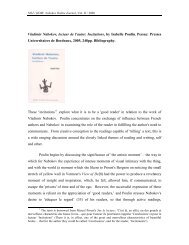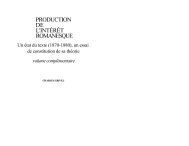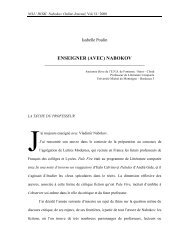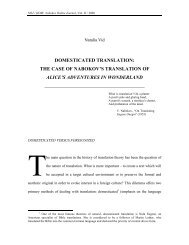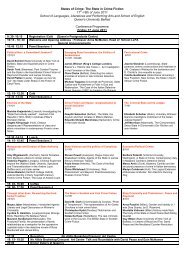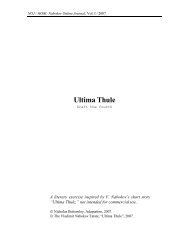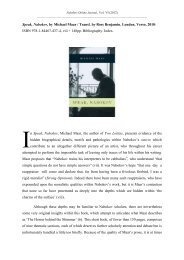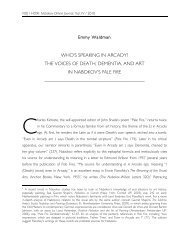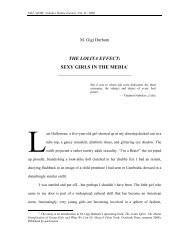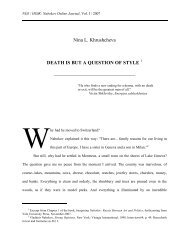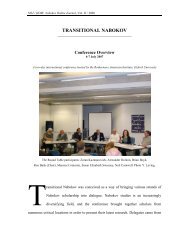musing upon the king's wreck - Electronic Text Centre
musing upon the king's wreck - Electronic Text Centre
musing upon the king's wreck - Electronic Text Centre
Create successful ePaper yourself
Turn your PDF publications into a flip-book with our unique Google optimized e-Paper software.
NOJ / НОЖ: Nabokov Online Journal, Vol. II / 2008<br />
Peter Lowe<br />
MUSING UPON THE KING’S WRECK:<br />
T. S. ELIOT’S THE WASTE LAND<br />
IN VLADIMIR NABOKOV’S PALE FIRE<br />
______________________________________________________<br />
‘There would be scarcely one masterpiece left<br />
untampered with and unchanged from beginning to end if<br />
we started to republish a dead author’s works in <strong>the</strong> form<br />
we think he might have wished <strong>the</strong>m to appear and endure.’<br />
– Nabokov, on <strong>the</strong> temptation to insert ‘draft’<br />
material into his translation of Eugene Onegin 1<br />
A<br />
s <strong>the</strong> 1980 publication of his Lectures on Literature revealed, Vladimir<br />
Nabokov was quick to share his admiration for some writers but equally<br />
scathing when referring to those he disliked ei<strong>the</strong>r as artists or as people,<br />
and T. S. Eliot was certainly one of <strong>the</strong> latter group. In a 1978 essay Douglas Fowler<br />
remarked <strong>upon</strong> Nabokov’s ‘abhorrence’ for Eliot’s work, a form of disgust which<br />
“fascinates us with its venomous energy.”(Fowler 44) 2 Referring to his own attempt to<br />
1 From Eugene Onegin: A Novel in Verse by Aleksandr Pushkin. Translated from <strong>the</strong> Russian with<br />
a Commentary by Vladimir Nabokov, in 4 Volumes, (1964). Volume 1:59.<br />
2 Fowler suggests two main reasons for Nabokov’s loathing of Eliot’s work: <strong>the</strong> taint of anti-<br />
Semitism in Eliot’s early poetry and criticism, which Nabokov (who had fled pre-war Germany with a<br />
Jewish wife) could not abide; and secondly <strong>the</strong> nature of Eliot’s vision of art as something that had to serve<br />
a spiritual or social purpose as something profoundly at odds with Nabokov’s more playful aes<strong>the</strong>ticism.
P. Lowe. “Musing on <strong>the</strong> King’s Wreck”<br />
re-read Eliot’s verse in 1947 Nabokov lamented its “pretentious vulgarity [and] tedious<br />
nonsense” (Boyd, American 188) and, writing to <strong>the</strong> New York Times Book Review in<br />
1949 he referred to Eliot as a “big fake” (Nabokov, Letters 90) and offered to debunk his<br />
reputation in print at <strong>the</strong> first opportunity. A direct assault was not forthcoming, but some<br />
of Nabokov’s disparagement arguably found expression in his reworking of a form that<br />
Eliot had made famous – <strong>the</strong> long poem with notes and ‘commentary’ – that came to be<br />
called Pale Fire, and was published in 1962.<br />
Pale Fire <strong>the</strong> novel is, of course, ‘Pale Fire’ <strong>the</strong> poem; John Shade’s last work,<br />
carefully annotated, explained, and presented by Charles Kinbote, a man who is ei<strong>the</strong>r <strong>the</strong><br />
exiled king of Zembla or a deluded visiting professor in <strong>the</strong> small American college town<br />
of New Wye who overstates both his ‘friendship’ with <strong>the</strong> deceased poet and his own<br />
presence in a poem whose meaning he ei<strong>the</strong>r fails to recognise or wilfully ignores. The<br />
novel is a work obsessed with <strong>the</strong> search for meaning, built for <strong>the</strong> most part on a mis-<br />
reading, originating in madness and held toge<strong>the</strong>r only by its own parody of order and<br />
sense. Indeed, whilst <strong>the</strong> <strong>the</strong>sis of a ‘mad’ Kinbote is widely held amongst readers and<br />
critics, it does not itself fully resolve <strong>the</strong> issue of <strong>the</strong> novel’s ‘ultimate’ meaning,<br />
reminding us that <strong>the</strong> responsibility for any conclusions resides as much with <strong>the</strong> reader<br />
as with <strong>the</strong> problematic text. 3<br />
For a novel so preoccupied with unity of composition and meaning, though, it is<br />
interesting to note that Pale Fire was not itself written in one clean sweep. Like many<br />
3 Nabokov’s novels have always provided critics with rich veins of material, never more so than in<br />
<strong>the</strong> field of (post)structuralist thinking. See for example David Cowart’s Literary Symbiosis: The<br />
Reconfigured <strong>Text</strong> in Twentieth-Century Writing (A<strong>the</strong>ns, GA: U of Georgia P, 1993); Maurice Couturier’s<br />
essay ‘The Near-Tyranny of <strong>the</strong> Author’ (published in Julian Connolly, ed. Nabokov and His Fiction: New<br />
Perspectives. Cambridge: Cambridge UP, 1999), and John Pier’s essay ‘Between <strong>Text</strong> and Paratext’, in<br />
Style. 26.1 (Spring 1992) 12-32.
NOJ / НОЖ: Nabokov Online Journal, Vol. II / 2008<br />
works of art it has its own group of attendant drafts and related fragments. Two of <strong>the</strong>se,<br />
later to be entitled ‘Solus Rex’ and ‘Ultima Thule’, date from Nabokov’s life in Europe in<br />
1939. 4 The idea of an exiled monarch’s story being told in a fragmented form is<br />
mentioned again in a letter of 24 th March 1957, but Nabokov’s teaching commitments at<br />
Cornell, <strong>the</strong> controversy surrounding <strong>the</strong> publication of Lolita, and his mammoth new<br />
translation and critical edition of Pushkin’s Eugene Onegin delayed work on <strong>the</strong> novel for<br />
several years. 5 Not until 1961 was <strong>the</strong> material worked into <strong>the</strong> form that we know today,<br />
when Nabokov contacted Esquire magazine with <strong>the</strong> following, slightly odd, suggestion:<br />
I do have material for you, and since you are brave you might like to consider it.<br />
It is a narrative poem […] supposed to be written by an American poet and<br />
scholar, one of <strong>the</strong> characters in my new novel, where it will be reproduced and<br />
annotated by a madman (Nabokov, Letters 329).<br />
Interestingly, this letter shows that Nabokov was happy for <strong>the</strong> poem ‘Pale Fire’<br />
to appear independently, with <strong>the</strong> substance of <strong>the</strong> <strong>the</strong>n-unfinished novel being glossed in<br />
a note appended to its text. Esquire declined <strong>the</strong> poem on <strong>the</strong> grounds that it did not<br />
publish poetry, and when ‘Pale Fire’ appeared before <strong>the</strong> world it did so as part of Pale<br />
Fire, a ‘novel’ in which Kinbote’s surreal commentary is inextricably fused with Shade’s<br />
4 Nabokov told Alfred Appel in 1967 that both of <strong>the</strong>se works (originally chapters in a Russian<br />
language novel started in 1939 and never finished) “belong to <strong>the</strong> same biological zone” as <strong>the</strong> fictional<br />
Zembla, adding that ‘Solus Rex’ “might have disappointed Kinbote less than Shade’s poem” (Dembo 43).<br />
Commenting on both works in 1973 he suggests that a “good reader […] “will certainly distinguish garbled<br />
echoes of this Russian novel of mine in Bend Sinister and, especially, Pale Fire” (Collected Stories 658).<br />
5 For more information on <strong>the</strong> relationship between Pale Fire and Nabokov’s text of Eugene<br />
Onegin see John O’Lyons’s ‘Pale Fire and <strong>the</strong> Fine Art of Annotation’ in L. S. Dembo (ed.) Nabokov: The<br />
Man and his Work (1967).
P. Lowe. “Musing on <strong>the</strong> King’s Wreck”<br />
work. 6 In a celebrated early review, Mary McCarthy, likened <strong>the</strong> novel to “a chess<br />
problem, an infernal machine” (McCarthy 71), unravelled some of its complexities, and<br />
pronounced it “one of <strong>the</strong> very great works of art of this century, <strong>the</strong> modern novel that<br />
everyone thought was dead and that was only playing possum” (McCarthy 84).<br />
With Nabokov’s comments on Eliot’s ‘fake’ credentials to guide <strong>the</strong>m, scholars<br />
have also been happy to read Pale Fire (both <strong>the</strong> poem and <strong>the</strong> surrounding material) as<br />
something of a pastiche of Eliot’s poetry, suggesting that in its formal qualities it echoes<br />
Four Quartets in structure and <strong>the</strong>me, and also that in <strong>the</strong> coming toge<strong>the</strong>r of poem and<br />
notes <strong>the</strong>re is an echo in part of The Waste Land, ano<strong>the</strong>r work that has been challenging<br />
existing boundaries since its publication in 1922.<br />
The complex history of The Waste Land was not clarified until <strong>the</strong> 1971<br />
publication of <strong>the</strong> poem’s manuscript revealed how Eliot’s fragmentary group of poems<br />
coalesced, with Ezra Pound’s editorial advice, into <strong>the</strong> work we know today. 7 Eliot told<br />
Paris Review in 1959 that he believed <strong>the</strong> original manuscript of <strong>the</strong> poem (sold to John<br />
Quinn in 1922) had been lost and, when pressed as to <strong>the</strong> nature of <strong>the</strong> now-absent<br />
material, alluded to “a long section about a ship<strong>wreck</strong>” (<strong>the</strong> much lengthier draft of<br />
‘Death by Water’) and “ano<strong>the</strong>r section which was an imitation Rape of <strong>the</strong> Lock”,<br />
excised on Pound’s advice (Cox & Hinchcliffe 25). Although Nabokov would have been<br />
unaware of The Waste Land’s genesis (had he even been interested), he may have known<br />
6 Like o<strong>the</strong>r novels from his ‘American’ years, Nabokov had written Pale Fire on index cards, a<br />
method he preferred because it made it easier to insert new material into a novel that was being composed<br />
on a piecemeal basis. The manuscript, which was sent to <strong>the</strong> Library of Congress in December 1961<br />
(divided into three separate packages) was “written in pencil on index cards of which <strong>the</strong>re are about<br />
1075”, divided into Foreword, Poem, Commentary, and Index. In case a librarian was unsure as to how<br />
<strong>the</strong>se sections fitted toge<strong>the</strong>r, Nabokov added that “<strong>the</strong> commentary is <strong>the</strong> novel.” (Nabokov, Letters 332)<br />
7 Recently, new light has been shed <strong>upon</strong> The Waste Land’s origins by Lawrence Rainey, in both<br />
his annotated text of <strong>the</strong> poem, complete with Eliot’s contemporary prose (2005) and his investigation into<br />
<strong>the</strong> forensics of <strong>the</strong> poem’s composition, Revisiting The Waste Land. (New Haven: Yale UP, 2005) Valerie<br />
Eliot’s 1971 Facsimile of <strong>the</strong> Manuscript with Pound’s annotations remains, of course, <strong>the</strong> definitive text.
NOJ / НОЖ: Nabokov Online Journal, Vol. II / 2008<br />
that, when published in The Criterion in October 1922, <strong>the</strong> poem stood, as Nabokov had<br />
intended ‘Pale Fire’ to stand when he offered it to Esquire, wholly without commentary.<br />
Only with its publication in book form, by Boni & Liveright in <strong>the</strong> US later in 1922 and<br />
Virginia and Leonard Woolf’s Hogarth Press in Britain in 1923, did it gain <strong>the</strong> associated<br />
notes that are now deemed integral to it. Like Nabokov’s novel, <strong>the</strong> poem intrigued<br />
reviewers as much as it impressed <strong>the</strong>m, with Edmund Wilson (later a keen<br />
correspondent with Nabokov) describing it with some frustration as “a puzzle ra<strong>the</strong>r than<br />
a poem,” that “can possess no higher interest than a full-rigged ship built in a bottle”<br />
(Miller 400).<br />
The saga of Eliot’s notes to The Waste Land divides opinion to this day as to<br />
whe<strong>the</strong>r or not, in purporting to clarify <strong>the</strong> poem’s ambiguities, <strong>the</strong>y complicate it fur<strong>the</strong>r.<br />
Eliot himself told a lecture audience in 1956 that his notes may have “stimulated <strong>the</strong><br />
wrong kind of interest among <strong>the</strong> seekers of sources,” sending <strong>the</strong>m “on a wild goose<br />
chase after Tarot cards and <strong>the</strong> Holy Grail” (Eliot, Frontiers 110). With <strong>the</strong> publication of<br />
<strong>the</strong> poem as a book in its own right Eliot felt that extra material was needed to bring <strong>the</strong><br />
“inconveniently short” work up to an acceptable length. 8 By <strong>the</strong> time he delivered his<br />
lecture ‘The Frontiers of Criticism,’ however, he saw <strong>the</strong> Notes as little more than a<br />
“remarkable exposition of bogus scholarship” (Eliot, Frontiers 109), but whilst he<br />
admitted that he had “sometimes thought of getting rid” of <strong>the</strong>m he had to concede that<br />
“<strong>the</strong>y can never be unstuck,” and were for better or worse integral to <strong>the</strong> poem.<br />
A novel as ceaselessly inventive as Pale Fire can be made to fit almost any<br />
critical paradigm, but I believe that its relationship to The Waste Land is in fact closer,<br />
8 See Pound’s letter to Eliot of 24 December 1921, cited in Eliot Letters 497.
P. Lowe. “Musing on <strong>the</strong> King’s Wreck”<br />
and considerably more complex, than previous studies have acknowledged. 9 Although it<br />
seems to have received nothing more than Nabokov’s carefully-directed disdain, The<br />
Waste Land both provides Pale Fire with a model for <strong>the</strong> format that it so assiduously<br />
mocks, and also explores several of <strong>the</strong> problems that <strong>the</strong> novel later addresses.<br />
On one level, both works are deeply concerned with <strong>the</strong> concept of self-<br />
consciousness, particularly in its capacity as a contributory factor to a breakdown in<br />
human relations that leaves people unable to understand each o<strong>the</strong>r. In both works,<br />
fur<strong>the</strong>rmore, voyeurism becomes an inadequate substitute for genuine engagement. On<br />
ano<strong>the</strong>r level, both works are concerned with <strong>the</strong> search for a ‘meaning’ that will bind<br />
<strong>the</strong>ir material toge<strong>the</strong>r in a sustaining myth or vision. Throughout The Waste Land, and in<br />
Shade’s poem ‘Pale Fire’, traces of an absolute reality persist, faintly glimpsed<br />
occasionally and sought via <strong>the</strong> ordered vision of aes<strong>the</strong>tic creation. Kinbote’s<br />
commentary on Shade’s poem also attempts to locate a sustaining myth, except that in his<br />
case it is a far-fetched tale of exiled royalty, with Kinbote at its centre, and all o<strong>the</strong>r<br />
figures important only in <strong>the</strong> degree to which <strong>the</strong>y impinge on his deluded consciousness.<br />
Whilst <strong>the</strong> textual echoes of Eliot’s poem within Pale Fire have been identified<br />
and analysed, it must be added that not all of <strong>the</strong>m can simply be read as instances of<br />
parody on Nabokov’s part. His use of Eliot’s words reveals a degree of indebtedness that<br />
exceeds his conscious disavowals of any such relationship and reminds <strong>the</strong> reader that<br />
two very different authors, in texts that are both similar and distinct, may explore <strong>the</strong><br />
9 In her detailed study of <strong>the</strong> novel, Find What <strong>the</strong> Sailor has Hidden: Vladimir Nabokov’s Pale<br />
Fire (Middletown, CT: Wesleyan UP, 1988) Priscilla Meyer identifies <strong>the</strong> shared textual material found in<br />
both The Waste Land and Pale Fire, but insists <strong>upon</strong> a distinction between <strong>the</strong> ‘mythical’ and<br />
‘disembodied’ world of Eliot’s poem and <strong>the</strong> greater reality that Shade’s meditation on life and death<br />
incorporates. Meyer does not, however, read both works as searches for meaning or aes<strong>the</strong>tic order, or<br />
explore <strong>the</strong> issues of self-consciousness that both works raise.
NOJ / НОЖ: Nabokov Online Journal, Vol. II / 2008<br />
pitfalls of self-conscious delusion and suggest means by which fragmented understanding<br />
may yet be woven into a cohesive whole. Upon closer examination, <strong>the</strong>n, <strong>the</strong> echoes of<br />
The Waste Land in Pale Fire make Nabokov’s ra<strong>the</strong>r dismissive references to Eliot seem<br />
oddly out of place. In looking again at <strong>the</strong> connections between <strong>the</strong> two works we may<br />
see that Eliot’s verse, which Nabokov was later to describe as “essentially platitudinous”<br />
(Speak 251), informs <strong>the</strong> work on a deeper level than simply that of a model set up to be<br />
undermined by <strong>the</strong> sharp Nabokovian wit.<br />
SIMILARITIES BETWEEN THE TWO WORKS:<br />
ISOLATION AND SELF-CONSCIOUSNESS<br />
Both The Waste Land and Pale Fire are concerned with self-consciousness,<br />
manifested both in an individual’s ability to construct his or her own reality and also to<br />
fail to see any correlation between that reality and <strong>the</strong> lives of those around <strong>the</strong>m. Both<br />
works are also concerned with problems of ‘connection,’ with <strong>the</strong> failure of characters to<br />
ever overcome <strong>the</strong> bounds of self-consciousness for long enough to find release from<br />
<strong>the</strong>ir own anguish, enmeshed as <strong>the</strong>y are in <strong>the</strong>ir own sense of self to <strong>the</strong> point at which<br />
<strong>the</strong> wider world becomes ‘unreal.’<br />
John Shade’s poem ‘Pale Fire’ is a Wordsworthian meditation on life and a<br />
possible ‘afterlife,’ but in Canto II, his meditations are lent extra, tragic force by <strong>the</strong><br />
suicide of his sensitive but physically plain daughter Hazel, who chose to drown herself<br />
one night after a blind date had come to nothing. Shade is also troubled that he knew so<br />
little of his daughter’s thoughts or actions on that fateful night or, indeed, at any point in
P. Lowe. “Musing on <strong>the</strong> King’s Wreck”<br />
her short, unhappy life. We learn that in her younger years he “sobbed in <strong>the</strong> men’s<br />
room” (38) after seeing his daughter in <strong>the</strong> role of a bent charwoman in a school pageant<br />
while all around her were fairies, but this may be suggestive more of his sense of failure<br />
than an understanding of Hazel’s torment, and it may be argued that it is only via his<br />
poem that he truly, retrospectively, understands her.<br />
Similar questions of ‘understanding’ permeate The Waste Land, indebted as it is<br />
to Eliot’s study of F. H. Bradley’s philosophy, and particularly to <strong>the</strong> concept of <strong>the</strong><br />
‘finite centre’ as a means of understanding human consciousness. In a Bradleyan view,<br />
each individual feels his or her own thoughts and sensations acutely, but has no objective<br />
way of knowing whe<strong>the</strong>r or not <strong>the</strong>se are shared with o<strong>the</strong>rs, a metaphysics that raises <strong>the</strong><br />
troubling possibility that what we consider to be our personal consciousness is ra<strong>the</strong>r an<br />
intricate form of imprisonment, foreclosing real understanding of those around us.<br />
It is actually through Hazel that Eliot’s verse enters ‘Pale Fire’ to a significant<br />
degree. Shade recalls one evening when, with each family member sitting in <strong>the</strong>ir own<br />
room, he overheard his daughter asking her mo<strong>the</strong>r for <strong>the</strong> definition of three words<br />
found in Eliot’s Four Quartets: ‘Grimpen,’ ‘Chtonic’ (her mis-spelling of Eliot’s<br />
‘chthonic’) and ‘Sempiternal.’ Shade dismisses <strong>the</strong> source of <strong>the</strong>se words as “some<br />
phoney modern poem” (40) and we may feel that Nabokov is using him to get in a shot at<br />
Eliot here. 10 Eliot’s importance in this passage, however, may reside not so much in <strong>the</strong><br />
10 Kinbote tells <strong>the</strong> reader that “I believe I can guess […] what poet is meant” but refrains from<br />
naming Eliot directly here without concrete proof, adding that “I deplore my friend’s vicious thrusts at <strong>the</strong><br />
most distinguished poets of his day” (154), Given Kinbote’s mental instability, however, his defence of<br />
Eliot can only possess <strong>the</strong> same degree of ‘reality’ as <strong>the</strong> rest of his comments, and so Nabokov may,<br />
paradoxically, be aiming a fur<strong>the</strong>r thrust at Eliot by insinuating that his poetry should be appreciated by<br />
such a man. In a letter to Meyer Abrams from January 1958 Nabokov referred to Eliot as “a minor poet of<br />
yesterday” (Nabokov, Letters 240) and Hazel Shade’s trick of reversing Eliot’s initials to make ‘toilest’ (or<br />
toilets) originates in Nabokov’s letter to Edmund Wilson of 21 st November 1948 (Nabokov-Wilson Letters<br />
213).
NOJ / НОЖ: Nabokov Online Journal, Vol. II / 2008<br />
words as <strong>the</strong> situation within which <strong>the</strong>y appear, where three people, each in <strong>the</strong>ir<br />
respective rooms, shout across to each o<strong>the</strong>r, seeking meanings for words that are hard to<br />
comprehend. Although in Shade’s view it does not matter what poem was being read that<br />
night, and that <strong>the</strong> importance of <strong>the</strong> memory to him resides in its image of <strong>the</strong> three<br />
people connected toge<strong>the</strong>r, he may be deceiving himself as to <strong>the</strong> nature of this<br />
connection, for whilst he supplies his daughter with <strong>the</strong> meaning of ‘sempiternal’, he<br />
does so via a ‘roar’ from behind <strong>the</strong> closed door of his study. This exchange, <strong>the</strong>n,<br />
although structured around <strong>the</strong> vocabulary of <strong>the</strong> Four Quartets, is perhaps more<br />
suggestive of <strong>the</strong> closing section of The Waste Land, with ‘each in his prison’ trying to<br />
locate <strong>the</strong> key that would release both someone else and <strong>the</strong>mselves:<br />
We think of <strong>the</strong> key, each in his prison<br />
Thinking of <strong>the</strong> key, each confirms a prison<br />
(412-13)<br />
Shade never really understood Hazel’s loneliness and desperation, and it is only<br />
through his poem that he tries to retrospectively gain such an insight. Even in its opening<br />
lines, however, <strong>the</strong> account of her final evening tells us that such knowledge remains<br />
largely abstract to him, for after confiding his belief that Hazel may, even her<br />
desperation, have “nursed a small mad hope” (40) he completes <strong>the</strong> rhyming couplet by<br />
telling us that her death came around <strong>the</strong> time when his own book on Pope was<br />
completed, thus suggesting that, occupied as he was with his own affairs, he failed to<br />
fully appreciate Hazel’s sadness, and can only mourn his “difficult” and “morose” darling<br />
(39) when she is gone.
P. Lowe. “Musing on <strong>the</strong> King’s Wreck”<br />
Faced with such a loss, Shade’s poem attempts to trace a purpose in what would<br />
o<strong>the</strong>rwise be random so that, ra<strong>the</strong>r than look back on <strong>the</strong> past and blunder through “an<br />
infinite maze of hopelessness and remorse” (167), in Kinbote’s phrase, he may find a<br />
“correlated pattern” that replaces <strong>the</strong> “flimsy nonsense” o<strong>the</strong>rs inhabit with a “web of<br />
sense” for <strong>the</strong> discerning beholder (53). Whilst this draws our thoughts most naturally<br />
towards Eliot’s Four Quartets, where <strong>the</strong> individual is freed from <strong>the</strong> pain of memory via<br />
contact with a transcendent order in which events and relationships that have been only<br />
partially understood are subsumed into a higher reality, <strong>the</strong> suggestion of this release is<br />
also present in The Waste Land’s concluding lines.<br />
Shade moves closer to a release from self-consciousness, ironically, through his<br />
toleration of Kinbote’s delusions, behaving remarkably politely towards one whom Sybil<br />
Shade describes as “an elephantine tick” (138). To be prepared to spend time, even if it is<br />
sometimes grudgingly, in such a person’s company suggests that Shade has taken a less<br />
self-conscious and more open approach to <strong>the</strong> lives of those woven into <strong>the</strong> “web of<br />
sense” within which he lives. That he and his poem should end up absorbed into ano<strong>the</strong>r<br />
man’s obsessive fantasy is a cruel outcome, but it should not conceal from <strong>the</strong> reader<br />
Shade’s willingness to engage in ano<strong>the</strong>r person’s world, which <strong>the</strong> close of The Waste<br />
Land suggests as a remedy for excessive self-consciousness:<br />
The awful daring of a moment’s surrender<br />
Which an age of prudence can never retract<br />
By this, and this only, we have existed<br />
Which is not to be found in our obituaries<br />
Or in memories draped by <strong>the</strong> beneficent spider
NOJ / НОЖ: Nabokov Online Journal, Vol. II / 2008<br />
Or under seals broken by <strong>the</strong> lean solicitor<br />
In our empty rooms.<br />
(403-9)<br />
Such moments of engagement often leave no trace in <strong>the</strong> wider world, but <strong>the</strong>y<br />
redeem <strong>the</strong> individual from <strong>the</strong> exclusive torment of his or her own concerns. Although<br />
he has guessed Kinbote’s delusional ‘secret’ Shade responds to his invitation for drinks<br />
by telling him he will “sample your wine with pleasure” (226), and out of a desire to<br />
humour <strong>the</strong> unstable exile strolls calmly to his fatefully mistaken death, attaining as he<br />
does so a release from selfhood which Kinbote manifestly fails to attain. In <strong>the</strong> conduct<br />
of Kinbote, by contrast, self-consciousness is taken to <strong>the</strong> lengths of psychological<br />
excess. Even in his critical re-working of Shade’s poem, his unwillingness to entertain<br />
any reading o<strong>the</strong>r than his own isolates him from <strong>the</strong> scholarly community, and his<br />
readiness to turn ano<strong>the</strong>r man’s loss into a reworking of his own concerns shows his<br />
inability to understand anyone o<strong>the</strong>r than himself, evident in <strong>the</strong> callousness with which<br />
he dismisses Hazel Shade as a “flabby, feeble, clumsy and solemn girl” (134).<br />
Both The Waste Land and Pale Fire incorporate instances where voyeurism<br />
becomes an inadequate substitute for genuine emotional engagement. The Waste Land’s<br />
characters are frequently seen (or ra<strong>the</strong>r spied on) by <strong>the</strong> wandering presence of Tiresias,<br />
a figure who, given <strong>the</strong> ‘gift’ of visionary understanding, finds it to be little more than a<br />
recipe for boredom because once you have “foresuffered all” <strong>the</strong>re is little left to<br />
discover. Describing <strong>the</strong> union of <strong>the</strong> typist and <strong>the</strong> ‘young man carbuncular’ he tells us<br />
that he “perceived <strong>the</strong> scene, and foretold <strong>the</strong> rest,” having seen a wealth of such
P. Lowe. “Musing on <strong>the</strong> King’s Wreck”<br />
encounters “enacted on this same divan or bed.” To such a consciousness nothing is ever<br />
emotionally valid.<br />
In place of Tiresias, Pale Fire features a man who, concealed by greenery, spies<br />
on his ‘friend’ through lit windows. There are several occasions when Kinbote enters <strong>the</strong><br />
Shades’ world unobserved, from his first sighting of <strong>the</strong>m (<strong>the</strong>y almost run him over by<br />
accident) to his final meeting with John in his garden and subsequent invitation for<br />
drinks. Like Tiresias, Kinbote is isolated from those around him, physically and<br />
emotionally, and cannot adopt an outlook by means of which such a condition may be<br />
overcome. Commenting on lines in which Shade expresses his love for his wife, he<br />
suggests that it would have been better if <strong>the</strong> reader had been spared <strong>the</strong>se “embarrassing<br />
intimacies” (140), showing as he does his inability to understand that such emotional<br />
openness is precisely <strong>the</strong> source of Shade’s strength as a rounded character.<br />
This difference is evident when Kinbote’s snooping interrupts Shade in <strong>the</strong> act of<br />
reading Canto II of <strong>the</strong> poem to his wife. Seeing Sybil Shade “huddle-shaking and<br />
blowing her nose” (74), and with John’s face all wet, Kinbote fails to see why <strong>the</strong> cards<br />
(playing cards, he assumes) spread on <strong>the</strong> divan between <strong>the</strong>m could be <strong>the</strong> cause of such<br />
distress. The reader has perhaps by this point deduced that that cards in question are<br />
actually <strong>the</strong> index cards on which Shade has written his poem, and that <strong>the</strong> couple’s<br />
distress stems from his having read to his wife <strong>the</strong> description of <strong>the</strong>ir daughter’s last<br />
night. Compared to this <strong>the</strong> baldness of Kinbote’s footnote in glossing <strong>the</strong> word ‘she’ in<br />
line 293 of <strong>the</strong> poem – “Hazel Shade, <strong>the</strong> poet’s daughter, born in 1934, died 1957 (see<br />
notes to lines 230 and 347)” (147) – highlights <strong>the</strong> complete breakdown of any
NOJ / НОЖ: Nabokov Online Journal, Vol. II / 2008<br />
correlation between his editorial efficiency and <strong>the</strong> emotional trauma that fuels and finds<br />
release in Shade’s verse.<br />
In Kinbote’s conversations with Shade, which predictably come to revolve around<br />
Zemblan material, we may also see a link with <strong>the</strong> chess-playing woman of The Waste<br />
Land Part II, peppering <strong>the</strong> air with questions while her companion sits lost in his own<br />
thoughts:<br />
Speak to me. Why do you never speak? Speak.<br />
What are you thinking of? What thinking? What?<br />
I never know what you are thinking. Think.<br />
(112-14)<br />
This woman never does know her companion’s thoughts because as her questions<br />
fall <strong>upon</strong> him thick and fast she never gives him time to communicate <strong>the</strong>m. She is<br />
interested in his thoughts only in so far as <strong>the</strong>y support her constructed and fragile sense<br />
of self. In this respect she resembles Kinbote who, forcing <strong>the</strong> tale of King Charles’s<br />
exile from Zembla on Shade, adds that “we never discussed […] any of my personal<br />
misfortunes” (24): a line that, in <strong>the</strong> reader’s mind, suggests that Shade was polite enough<br />
to humour his neighbour, and that Kinbote, like Humbert Humbert, could only interpret<br />
his dealings with o<strong>the</strong>rs on his own compromised terms.<br />
In both works, <strong>the</strong>n, isolation is a very real problem, whe<strong>the</strong>r seen in <strong>the</strong> multiple<br />
isolation of The Waste Land, or <strong>the</strong> breakdown of Shade’s relationship with his daughter,<br />
or Kinbote’s total lack of contact with wider reality. In this regard, both works provide<br />
examples of a perceived need to ‘construct’ <strong>the</strong> self and buttress it against <strong>the</strong> threat of
P. Lowe. “Musing on <strong>the</strong> King’s Wreck”<br />
dissolution. Paradoxically, <strong>the</strong> more <strong>the</strong> self is ‘defined’ <strong>the</strong> fur<strong>the</strong>r removed from <strong>the</strong><br />
world it becomes, for only in a willingness to concede that <strong>the</strong>re may be a degree of<br />
reality greater than <strong>the</strong> individual’s perception is true interaction between self and world<br />
to be found.<br />
SELF-DEFINITION / SELF-DOUBT<br />
Acute self-consciousness impels <strong>the</strong> self to seek confirmation of its perceptions in<br />
<strong>the</strong> wider world in order to obtain proof of its own ‘rightness’. For John Shade points of<br />
intersection with a greater reality become a route to overcoming self-consciousness<br />
because <strong>the</strong>y direct his thoughts to a state into which individual concerns are subsumed.<br />
Kinbote, on <strong>the</strong> o<strong>the</strong>r hand, can only project onto <strong>the</strong> world around him a version of what<br />
he keeps within, and as such echoes more strongly <strong>the</strong> characters of The Waste Land,<br />
who constantly seek reassurance from those around <strong>the</strong>m, each trapped inside an<br />
individual, if well-constructed, hell. Both works illustrate, however, that such<br />
construction does not in itself preserve <strong>the</strong> self in <strong>the</strong> world but ra<strong>the</strong>r removes linkage<br />
between self and world, leaving <strong>the</strong> self secure only <strong>the</strong> scope of its illusory existence.<br />
We meet <strong>the</strong> first example of a ‘constructed self’ early in The Waste Land in <strong>the</strong><br />
form of Marie, <strong>the</strong> German countess who is at pains to assure us of her ‘true’ Germanic<br />
roots (which are <strong>the</strong>mselves something of an illusion as she comes from Lithuania) and<br />
who locates a sense of identity in <strong>the</strong> memory of past winters holidaying with her cousin,<br />
<strong>the</strong> Archduke. 11 Such issues also come to <strong>the</strong> fore in <strong>the</strong> exchange between <strong>the</strong> chess-<br />
11 Lawrence Rainey translates Marie’s line as “I am not a Russian. I come from Lithuania, a real<br />
German” (Eliot / Rainey, Annotated Waste Land 77).
NOJ / НОЖ: Nabokov Online Journal, Vol. II / 2008<br />
playing couple of Part II. The woman is in constant need of reassurance and peppers <strong>the</strong><br />
air with unanswered questions in an attempt to gain from her silent partner <strong>the</strong> replies that<br />
would buttress her own sense of reality:<br />
‘What is that noise?’<br />
The wind under <strong>the</strong> door.<br />
‘What is that noise now? What is <strong>the</strong> wind doing?’<br />
Nothing again nothing. […]<br />
‘What shall I do now? What shall I do?<br />
(117-120, 131)<br />
The woman needs <strong>the</strong> man’s replies to set her own troubled mind at rest. When<br />
<strong>the</strong>se are not forthcoming (he answers only within his own consciousness, and does not<br />
actually talk to her) her thoughts become still more disjointed, threatening bizarre action<br />
in order to reaffirm her tenuous grip on reality. These lines are echoed in ‘Pale Fire,’<br />
when John and Sibyl Shade, grief-stricken by <strong>the</strong>ir daughter’s death, initially try to play<br />
down any signs that her spirit may be returning to <strong>the</strong>m:<br />
‘What is that funny creaking – do you hear?’<br />
‘It is <strong>the</strong> shutter on <strong>the</strong> stairs, my dear.’<br />
‘If you’re not sleeping, let’s turn on <strong>the</strong> light.<br />
I hate that wind! Let’s play some chess.’ ‘All right.’
‘I’m sure it’s not <strong>the</strong> shutter. There – again.’<br />
‘It is a tendril fingering <strong>the</strong> pane.’ […]<br />
‘And now what shall I do? (48)<br />
P. Lowe. “Musing on <strong>the</strong> King’s Wreck”<br />
John Burt Foster describes <strong>the</strong>se lines as “a brief, ra<strong>the</strong>r episodic parody” (Foster<br />
65) of The Waste Land, but if we read both passages as examples of an individual<br />
anxious to have <strong>the</strong>ir reality confirmed by ano<strong>the</strong>r party, reminders of how flimsy our<br />
construction of <strong>the</strong> ‘real’ may turn out to be, Nabokov’s borrowings from Eliot’s poem<br />
suggest a deeper degree of engagement. At <strong>the</strong> very least <strong>the</strong> resonances in <strong>the</strong> passage<br />
cited above make his claim, made in a 1958 letter to Edmund Wilson, that Eliot’s verses<br />
never lodged in his head, sound ra<strong>the</strong>r disingenuous (Nabokov–Wilson, Letters 323).<br />
Shade’s poem is concerned with <strong>the</strong> transcendence of self-conscious via reference<br />
to a greater reality, but once in <strong>the</strong> grip of Kinbote’s commentary it becomes subject to<br />
his editorial delusion. Kinbote needs to locate Zemblan references in <strong>the</strong> poem because<br />
without <strong>the</strong>m <strong>the</strong> whole edifice of his fantasy becomes null and void. This explains <strong>the</strong><br />
venom with which Kinbote disparages <strong>the</strong> ‘Appreciation’ of Shade published by<br />
Professor Hurley, which “contains not one reference to <strong>the</strong> glorious friendship that<br />
brightened <strong>the</strong> last months of John’s life” (83) and is <strong>the</strong>refore an attack on his very<br />
existence. To call into question any part of his illusion is to impugn <strong>the</strong> whole – hence<br />
Kinbote’s jealously guarding <strong>the</strong> manuscript of Shade’s poem, only promising to hand<br />
over <strong>the</strong> original text once he has safely ‘prepared’ it. Like ‘V’, <strong>the</strong> narrator of The Real<br />
Life of Sebastian Knight (1939), Kinbote’s editorial activities are nei<strong>the</strong>r as altruistic nor<br />
as transparent as <strong>the</strong>y initially appear.
NOJ / НОЖ: Nabokov Online Journal, Vol. II / 2008<br />
Throughout his Commentary Kinbote attempts to locate himself in Shade’s poem<br />
via oblique and tenuous means, at one point even using <strong>the</strong> innocuous word ‘often’ as <strong>the</strong><br />
starting point for a lengthy passage on his own fear of assassination, but <strong>the</strong> lengths to<br />
which he pursues such connections are suggestive of his need to define himself through<br />
<strong>the</strong>m. As Alvin Kernan notes, Kinbote “is trying to get Shade to confirm his identity, to<br />
validate <strong>the</strong> Zemblan reality which is his hope of salvation by making it into a poem”<br />
(Bloom 118). We gain an insight into his reasoning on this subject in his words to Shade<br />
when <strong>the</strong> poet has questioned <strong>the</strong> veracity of <strong>the</strong> Zemblan material:<br />
‘My dear John,’ I replied gently and urgently, ‘do not worry about trifles. Once<br />
transmuted by you into poetry, <strong>the</strong> stuff will be true, <strong>the</strong> people will come alive.<br />
A poet’s purified truth can cause no pain, no offense. True art is above false<br />
honor.’ (170)<br />
In this context, we hear such words only through Kinbote’s delusional reality, but<br />
whilst <strong>the</strong>y serve to illustrate <strong>the</strong> importance of self-definition (and <strong>the</strong> confirmation of<br />
that definition by ano<strong>the</strong>r person) <strong>the</strong>y also testify to <strong>the</strong> ability of art to make sense of<br />
reality. Having located in a draft variant lines from Pope’s Essay on Man that refer to a<br />
world in which a “sot” may be a hero or a “lunatic a king” Kinbote attributes <strong>the</strong><br />
exclusion of such lines from <strong>the</strong> final poem to Shade’s unwillingness to offend “an<br />
au<strong>the</strong>ntic king”, whose secret he had, by that point, guessed (161). Shade may well have<br />
omitted <strong>the</strong> reference out of a desire not to offend, but it is more likely that it was<br />
Kinbote <strong>the</strong> lunatic who he was anxious to shield from <strong>the</strong> allusion, not Kinbote <strong>the</strong><br />
monarch. Such speculations show <strong>the</strong> extent to which Kinbote is prepared to warp
P. Lowe. “Musing on <strong>the</strong> King’s Wreck”<br />
Shade’s reality in order to legitimate his own vision, coupled with his refusal to concede<br />
that he lacks relevance to “anything outside <strong>the</strong> desperate compensations of his own<br />
mind” (Boyd, Magic 61). It is, as he tells <strong>the</strong> reader, “evil piffle to assert that he [Gradus]<br />
aimed not at me” (231) or to accept that Jack Grey was not an assassin sent from Zembla.<br />
The absence of <strong>the</strong> Zemblan <strong>the</strong>me would deprive Kinbote of his very reason for living,<br />
and Nabokov went on to suggest in an interview with Alfred Appel, that Kinbote actually<br />
killed himself when his editorial labours were completed, suggesting that Kinbote’s<br />
words “my work is finished. My poet is dead” (236) connect his fate inextricably with<br />
that of his book’s subject and subject matter. 12<br />
Lecturing on Don Quixote at Harvard in 1952, Nabokov described <strong>the</strong> Don as “a<br />
crazy sane man, or an insane one of <strong>the</strong> verge of sanity; a striped madman, a dark mind<br />
with lucid interspaces,” a man for whom “reality and illusion are interwoven in <strong>the</strong><br />
pattern of life” (DQ Lectures 17). Kinbote, however, is too far-gone in his delusion to see<br />
even a blurring of <strong>the</strong> distinctions between ‘real’ and ‘invented’ reality. Compared to<br />
him <strong>the</strong> Don’s madness is largely benevolent, whereas his own insanity is an attempt not<br />
just to read his illusions into <strong>the</strong> world around him but to attempt to re-write that world in<br />
order to validate his own perspective. As Michael Seidel points out, “Kinbote has <strong>the</strong><br />
kind of blindness characteristic of too much vision; he ei<strong>the</strong>r interprets too much (<strong>the</strong><br />
Zemblan master key) or too little (stopping <strong>the</strong> seepages so detrimental to his sanity)”<br />
(Seidel 853).<br />
In his Foreword Kinbote even tries to subvert <strong>the</strong> practice of reading a book<br />
sequentially, telling <strong>the</strong> reader that although his notes follow Shade’s poem <strong>the</strong> reader<br />
12 See Alfred Appel Jr, ‘An Interview with Vladimir Nabokov’ in Dembo (ed.) Nabokov: The Man<br />
and his Work, p. 29.
NOJ / НОЖ: Nabokov Online Journal, Vol. II / 2008<br />
would be well advised to read <strong>the</strong>m first, <strong>the</strong>n study <strong>the</strong> poem “with <strong>the</strong>ir help” and <strong>the</strong>n<br />
read <strong>the</strong>m again, “having done with <strong>the</strong> poem” (25). Thus his commentary supplants <strong>the</strong><br />
original text, reading into <strong>the</strong> “many pithy lines carelessly rejected” (25) by Shade a form<br />
of order that admits “not one gappy line, not one doubtful reading” (14). For <strong>the</strong> reader,<br />
however, increasingly aware of how forcibly Kinbote’s fantasy is interwoven with<br />
Shade’s poem, this ‘clarity’ seems somewhat questionable, and it may not be<br />
coincidence, perhaps, that <strong>the</strong> majority of <strong>the</strong> Zemblan <strong>the</strong>me resides in <strong>the</strong> poem’s<br />
marginalia. It is indeed quite conceivable, given that we are told of Shade’s habit of<br />
burning draft material once it was no longer needed, that <strong>the</strong> drafts and variants produced<br />
by Kinbote to substantiate some of his claims may not even be Shade’s work at all. In his<br />
note to Line 12, where Shade’s usage of <strong>the</strong> words ‘crystal land’ is pounced <strong>upon</strong> by<br />
Kinbote as an allusion to Zembla, he proceeds to cite a couplet to reinforce <strong>the</strong><br />
connection – “Ah, I must not forget to say something / That my friend told me of a<br />
certain king” (62) – but immediately adds that such lines come not from <strong>the</strong> fair copy of<br />
<strong>the</strong> poem but from a “disjointed, half-obliterated draft which I am not sure I have<br />
deciphered properly” (62).<br />
Such comments remind <strong>the</strong> reader of how Kinbote is searching for meaning in<br />
Shade’s poem, anxious to find his delusions corroborated. Shade, for his part, is<br />
searching for a matrix of meaning within which his life and associated events will make<br />
some degree of sense. In The Waste Land, characters are aware, sometimes only briefly,<br />
of <strong>the</strong> fragility of <strong>the</strong>ir constructed ‘selves’ and troubled by <strong>the</strong> sense that <strong>the</strong>y are lacking<br />
a connection with a greater reality, or higher ‘meaning’. It is this search for meaning that<br />
informs <strong>the</strong> most interesting connections between <strong>the</strong> The Waste Land and Pale Fire,
P. Lowe. “Musing on <strong>the</strong> King’s Wreck”<br />
revealing in <strong>the</strong> end <strong>the</strong> extent to which Nabokov, as dismissive of its author as he was,<br />
may well have found within Eliot’s poem a template for <strong>the</strong> search for meaning he was<br />
later to weave into his novel.<br />
THE SEARCH FOR MEANING: GLIMPSES OF A TRANSCENDENT REALITY<br />
Within <strong>the</strong> tradition bequea<strong>the</strong>d by <strong>the</strong> Romantic poets, <strong>the</strong> ‘spots of time’ that<br />
animate Shade’s poem are suggestive of a transfigured reality that exceeds that of <strong>the</strong><br />
individual. Canto I of ‘Pale Fire’ traces Shade’s Wordsworthian search for meaning<br />
amidst <strong>the</strong> experiences of childhood, where <strong>the</strong> ‘child of nature’ (both parents having<br />
died in his infancy) forges his worldview from his early perceptions of life. These<br />
moments of insight in early years often take <strong>the</strong> form of fits or seizures (“a sudden<br />
sunburst in my head”) and momentary lapses in consciousness. For a suitably attuned<br />
outlook, however <strong>the</strong>y offer glimpses of a world beyond existing reality, points of<br />
intersection between <strong>the</strong> individual and <strong>the</strong> wider universe that irradiate <strong>the</strong> present to<br />
which <strong>the</strong> individual returns after being “distributed through space and time” (33). A<br />
similar experience lies at <strong>the</strong> heart of The Waste Land Part I, and is arguably, as David<br />
Moody notes, “<strong>the</strong> centre from which <strong>the</strong> entire poem radiates” (Moody 81), imbued as it<br />
is with a trace of mystical, as well as sexual, rapture:<br />
Yet when we came back, late, from <strong>the</strong> hyacinth garden,<br />
Your arms full, and your hair wet, I could not<br />
Speak, and my eyes failed, I was nei<strong>the</strong>r<br />
Living nor dead, and I knew nothing,
NOJ / НОЖ: Nabokov Online Journal, Vol. II / 2008<br />
Looking into <strong>the</strong> heart of light, <strong>the</strong> silence.<br />
(37-41)<br />
This fusion of emotional and spiritual awakening is phrased in negative terms<br />
because <strong>the</strong>y are <strong>the</strong> only means by which <strong>the</strong> perceiving consciousness can relate <strong>the</strong><br />
force of its experience. The man who says <strong>the</strong>se lines has, briefly, glimpsed a higher<br />
form of reality, much <strong>the</strong> same as <strong>the</strong> young John Shade, whose seizures, leading as <strong>the</strong>y<br />
did to a similar suspension of sensory activity, become signposts on <strong>the</strong> route to infinity<br />
that his poem now tries to retrace.<br />
To have experienced and <strong>the</strong>n lost such an insight is a source of pain for <strong>the</strong><br />
individual. Although a doctor passes Shade’s fainting fits off as “mainly growing pains”,<br />
he adds in his poem that such experiences are not so easily set aside, and his line “<strong>the</strong><br />
wonder lingers and <strong>the</strong> shame remains” (33) suggests that normal life is no longer<br />
satisfactory in <strong>the</strong> wake of such a vision. Kinbote sees in <strong>the</strong>se lines evidence only of “a<br />
mild form of epilepsy, a derailment of <strong>the</strong> nerves at <strong>the</strong> same spot, on <strong>the</strong> same curve of<br />
<strong>the</strong> tracks, every day, for several weeks” (119). If he could truly appreciate what Shade<br />
had glimpsed here, however, he would see ‘Pale Fire’ as a search to regain <strong>the</strong> intensity<br />
of such early experiences, fuelled by <strong>the</strong> sense that a greater (or at least more complete)<br />
reality is eluding <strong>the</strong> individual. The death of Hazel, <strong>the</strong> single most traumatic event<br />
related within <strong>the</strong> poem, thus becomes a focal point that legitimates this quest for a<br />
greater, unifying order.<br />
Shade initially subverts suggestions of an afterlife in his description of <strong>the</strong><br />
Institute of Preparation for <strong>the</strong> Hereafter, whose initials, phonetically, give a far from
P. Lowe. “Musing on <strong>the</strong> King’s Wreck”<br />
convincing ‘iph’ (if). In his first dealings with <strong>the</strong> Institute he doubts <strong>the</strong> validity of its<br />
claims, and whilst <strong>the</strong> residual interest left by his childhood insights into eternity makes<br />
him reluctant to dismiss <strong>the</strong> afterlife altoge<strong>the</strong>r in <strong>the</strong> wake of Hazel’s death he expresses<br />
his doubt in <strong>the</strong> ability of <strong>the</strong> spirit world to return to <strong>the</strong> material, adding that “I knew<br />
<strong>the</strong>re would be nothing: no self-styled / Spirit would touch a keyboard of dry wood / To<br />
rap out her pet name” (48). When his childhood insights are <strong>the</strong>mselves replaced with a<br />
near-death experience in adulthood, however, his search for meaning returns with<br />
renewed vigour. Although <strong>the</strong> doctor who revives him disputes that Shade was able to<br />
hallucinate in his unconscious condition, <strong>the</strong> poet, like a character in Eliot’s verse, keeps<br />
“replaying <strong>the</strong> whole thing” in mind in an attempt to locate meaning in it:<br />
My vision reeked with truth. It had <strong>the</strong> tone,<br />
The quiddity and quaintness of its own<br />
Reality. It was.<br />
(51)<br />
As if to give <strong>the</strong> lie to Shade’s visions, however, his point of contact with an<br />
afterlife is initially founded <strong>upon</strong> error and delusion. Having been gifted with a glimpse<br />
of <strong>the</strong> hereafter illuminated by ‘a tall white fountain,’ he seizes <strong>upon</strong> <strong>the</strong> reported vision<br />
of a woman who, in near-death state, recorded a similar vision, only for his enquiries to<br />
reveal that she actually encountered a tall white mountain, and that what seemed at first<br />
to be a bond between <strong>the</strong>ir visions of <strong>the</strong> afterlife is little more than an erroneous illusion.<br />
‘Life everlasting,’ it would appear, is founded on little more than a misprint (53).
NOJ / НОЖ: Nabokov Online Journal, Vol. II / 2008<br />
At <strong>the</strong> point of failure, however, Shade finds renewed belief in <strong>the</strong> ‘rightness’ of<br />
his search for meaning. As Boyd notes, “it is not that deflating recognition […] but <strong>the</strong><br />
resolve that follows it, that forms <strong>the</strong> core and key to <strong>the</strong> poem” (Boyd, Magic 30). The<br />
‘contrapuntal’ <strong>the</strong>me within which disparate strands are interwoven is not evidence of <strong>the</strong><br />
lack of order, but ra<strong>the</strong>r testimony to <strong>the</strong> richness and diversity of order around us – not<br />
‘flimsy nonsense’ at all, but <strong>the</strong> ‘sense’ that makes things cohere. Thus while <strong>the</strong><br />
disappointment of Canto III ends with Shade’s words to his wife, “I have returned<br />
convinced that I can grope / My way to some – to some […] Faint hope” (53) this<br />
tentative affirmation fuels <strong>the</strong> expansiveness of Canto IV, in which Shade gives free rein<br />
to his belief in unifying, if well-concealed order beneath <strong>the</strong> world as he sees it, ending<br />
<strong>the</strong> poem as he does in a vision within all things occupy an assigned place. Unsure of<br />
how to set this down for his reader, he turns to <strong>the</strong> harmony of poetry to describe such an<br />
ordered creation:<br />
I feel I understand<br />
Existence, or at least a minute part<br />
Of my existence, only through my art,<br />
In terms of combinational delight;<br />
And if my private universe scans right,<br />
So does <strong>the</strong> verse of galaxies divine<br />
Which I suspect is an iambic line.<br />
(58)
P. Lowe. “Musing on <strong>the</strong> King’s Wreck”<br />
Within such a formal union (something that Eliot did not explore in depth in The<br />
Waste Land but which was central to his vision in Four Quartets) Shade is able to make<br />
sense of his pain and confusion by aligning it with a transcendent reality. This is, in its<br />
own way, a variation on <strong>the</strong> ‘guiding myth’ of Romantic poetry – <strong>the</strong> integrity of <strong>the</strong><br />
individual consciousness and its simultaneous relationship to an Absolute guiding force –<br />
and shows that Shade’s poem, taken aside from its Commentary, pursues a route to a<br />
higher reality similar to that sketched out in The Waste Land.<br />
Set against Shade’s experience of life and death, Kinbote’s delusion seems little<br />
more than a form of mania, but in his own way he too is a displaced consciousness<br />
insofar as his mental instability functions as a form of ‘insight’ into a higher, more<br />
cohesive, world-view. Kinbote tells <strong>the</strong> reader that on his first skimmed reading of <strong>the</strong><br />
Shade’s poem, “as a furious young heir through an old deceiver’s testament” (232) he felt<br />
let down by its exclusion of <strong>the</strong> thoughts and ‘memories’ he supplied, and felt it<br />
necessary both to attribute this to Sybil Shade’s all too effective editorial work and <strong>the</strong>n<br />
supply himself <strong>the</strong> clarifying commentary at any point where a link could (tenuously) be<br />
drawn.<br />
In his Foreword Kinbote tells <strong>the</strong> reader that “I alone am responsible for any<br />
mistakes in <strong>the</strong> commentary” (17), but when he concedes that <strong>the</strong>re has been one instance<br />
in which he has jumped too hastily to a wrong conclusion, and adds in a note to line 550<br />
of <strong>the</strong> poem that his earlier desire to see a reference to Zembla in <strong>the</strong> “crystal land” of<br />
line 12 was “distorted and tainted by wishful thinking” (180) he simultaneously singles<br />
out his only error and stresses <strong>the</strong> veracity of all his o<strong>the</strong>r interpretations, even his<br />
assertion that <strong>the</strong> proposed final line of <strong>the</strong> poem was actually a reprisal of its opening
NOJ / НОЖ: Nabokov Online Journal, Vol. II / 2008<br />
one, <strong>the</strong>reby testifying to his belief that a greater pattern is located behind Shade’s poem<br />
than even its author understood.<br />
In both Pale Fire and The Waste Land we find <strong>the</strong> suggestion of an absolute<br />
realm of order and meaning glimpsed briefly, if at all, but whilst notions of a ‘guiding<br />
myth’ are often frustrated and downplayed it does not mean that <strong>the</strong> search for such a<br />
myth has been of little or no use. Ra<strong>the</strong>r, in both works <strong>the</strong>re is evidence of a desire for<br />
such myths to exist and <strong>the</strong> suggestion that, via <strong>the</strong> medium of art, <strong>the</strong>y may be briefly<br />
discerned.<br />
‘REAL’ LIFE (RE)ORDERED AS ART<br />
Interviewed in 1962, Nabokov described <strong>the</strong> relationship between memory and<br />
consciousness as “a matter of love: <strong>the</strong> more you love a memory, <strong>the</strong> stronger and<br />
stranger it is” (Strong Opinions 12). In Pale Fire, as in The Waste Land, it is in <strong>the</strong> sphere<br />
of memory that order is sought and located. In Shade’s poem and, in a mirrored manner,<br />
in Kinbote’s commentary, past events are revisited and glossed in order to assume <strong>the</strong>ir<br />
full meaning. This process can result in error as much as success, but it can also function<br />
as a genuine insight into our own lives and <strong>the</strong> wider matrices of <strong>the</strong> world around us, as<br />
found in ‘Pale Fire’ itself, a hymn to an ordering principle faintly glimpsed but<br />
never<strong>the</strong>less present in <strong>the</strong> flux of lived experience.<br />
Both works are concerned with <strong>the</strong> relationship between life and death, and <strong>the</strong><br />
extent to which our awareness of one colours our perception of <strong>the</strong> o<strong>the</strong>r. Writing on <strong>the</strong><br />
Institute or Preparation for <strong>the</strong> Hereafter Shade recalls that in <strong>the</strong> midst of its work
P. Lowe. “Musing on <strong>the</strong> King’s Wreck”<br />
getting people ready for death it overlooked something fundamental about <strong>the</strong><br />
relationship between death and life:<br />
For we die everyday; oblivion thrives<br />
Not on dry thighbones but on blood-ripe lives,<br />
And our best yesterdays are now foul piles<br />
Of crumpled names, phone numbers and foxed files.<br />
(44)<br />
These lines, echoing Macbeth’s words <strong>upon</strong> his wife’s death, posit <strong>the</strong> view that<br />
our end is an integral element in our life, and that preparation for what comes next should<br />
see us reconciled to that ordering principle, something that, in making death more<br />
mysterious than it is, <strong>the</strong> Institute fails to do. The poem ‘Pale Fire’ expresses Shade’s<br />
desire to believe in a form of order that makes sense of <strong>the</strong> world around him, and in his<br />
usage of rhyming couplets (popular in <strong>the</strong> Eighteenth Century or ‘Age of Reason’) he<br />
draws his reader back to a time when belief in an orderly universe was more widespread<br />
and when harmony and proportion were highly valued. Re-working life into art helps<br />
Shade understand a higher form of reality than he has hi<strong>the</strong>rto explored, uniting his<br />
childhood ‘visions,’ <strong>the</strong> loss of his daughter, and his near-death experience into a<br />
cohesive and satisfying whole.<br />
Deluded as he is, Kinbote’s ‘memories’ are as real to him as Shade’s, and <strong>the</strong>y<br />
inform his search for order and meaning in <strong>the</strong> same manner, providing instances of deep<br />
emotional loss and pain, like his account of how Charles <strong>the</strong> Beloved, unable to renounce<br />
his homosexual tendencies, parted from his wife Disa in a French Riviera garden, a
NOJ / НОЖ: Nabokov Online Journal, Vol. II / 2008<br />
parting that increasingly came to occupy a place in his memory out of proportion to <strong>the</strong><br />
original event:<br />
He dreamed of her more often, and with incomparably more poignancy, than his<br />
surface-life feelings for her warranted. […] These heartrending dreams<br />
transformed <strong>the</strong> drab prose of his feelings for her into strong and strange poetry,<br />
subsiding undulations of which would flash and disturb him throughout <strong>the</strong> day,<br />
bringing back <strong>the</strong> pang and <strong>the</strong> richness – and <strong>the</strong>n only <strong>the</strong> pang, and <strong>the</strong>n only<br />
its glancing reflection. (166)<br />
In its exploration of <strong>the</strong> extent to which memory, coupled with aes<strong>the</strong>tic creation,<br />
works to transform an event into a ‘scene’, this passage has strong echoes of Eliot’s ‘La<br />
Figlia Che Piange’, where a departing lover tries to restage <strong>the</strong> actual moment of farewell<br />
in a more aes<strong>the</strong>tically satisfying manner that accords better with his desired ‘memory’<br />
but drifts ever fur<strong>the</strong>r from <strong>the</strong> less regulated emotional focal-point from which it was<br />
drawn:<br />
She turned away, but with <strong>the</strong> autumn wea<strong>the</strong>r<br />
Compelled my imagination many days, […]<br />
And I wonder how <strong>the</strong>y should have been toge<strong>the</strong>r!<br />
I should have lost a gesture and a pose.<br />
Sometimes <strong>the</strong>se cogitations still amaze<br />
The troubled midnight and <strong>the</strong> noon’s repose.
P. Lowe. “Musing on <strong>the</strong> King’s Wreck”<br />
Eliot’s poem, like Shade’s, attests to <strong>the</strong> process by which lived life is transmuted<br />
into art – something that, even in <strong>the</strong> midst of his fantasy, Kinbote endeavours to attain.<br />
For David Rampton <strong>the</strong> episode of Charles’s parting from Disa is <strong>the</strong> “clear emotional<br />
centre” (Rampton 153) of Pale Fire, and in its poignancy it is hard to be as dismissive of<br />
it as one can be with o<strong>the</strong>r parts of Kinbote’s delusions, as he is clearly searching, like<br />
Shade, for coherence and meaning, locating <strong>the</strong> contents of his fragmented consciousness<br />
into a frame supplied by <strong>the</strong> o<strong>the</strong>r man’s art, reminding us that, as Humbert says at <strong>the</strong><br />
end of Lolita, “<strong>the</strong> refuge of art” is “<strong>the</strong> only immortality” that can be shared in a world<br />
where <strong>the</strong> individual’s experience is o<strong>the</strong>rwise lost (Lolita 309).<br />
Critics of The Waste Land have often delighted in teasing out each of its myriad<br />
textual references and echoes, arguing that in employing such material Eliot is suggesting<br />
that <strong>the</strong> present is a debased copy of <strong>the</strong> past, or that life is much less poetic than art lets<br />
us believe. It may also be argued, however, that <strong>the</strong> poem’s wealth of citation is meant to<br />
resonate in <strong>the</strong> reader’s consciousness, not simply to stand out in contrast to modernity,<br />
but to inform it and give it meaning. Our perception of reality is, in part, conditioned by<br />
culture, and if that culture is seen as being in decline in The Waste Land Eliot sounds a<br />
call to store ‘fragments’ of it whenever possible, so that creation may begin again out of<br />
modernity’s ‘dissociated sensibility’ and disjointed failure. 13<br />
Whilst <strong>the</strong> individual’s emotion may be lost in time, The Waste Land reminds us<br />
that a work of art can capture emotion and store it. When, at <strong>the</strong> close of Part II <strong>the</strong><br />
conversation of <strong>the</strong> women in <strong>the</strong> pub gives way to Ophelia’s parting words from Hamlet<br />
<strong>the</strong>ir talk of female sexuality and male infidelity takes on a keener edge. When <strong>the</strong> crowd<br />
13 For Eliot’s analysis of <strong>the</strong> “dissociation of sensibility” in modern culture see his 1921 essay<br />
‘The Metaphysical Poets’ in Selected Essays (1932, London: Faber, 1999), pp. 281-291.
NOJ / НОЖ: Nabokov Online Journal, Vol. II / 2008<br />
crossing London Bridge is likened to <strong>the</strong> souls in a Dantean Hell <strong>the</strong>ir condition is thrown<br />
into sharper relief. In <strong>the</strong> same capacity, <strong>the</strong> unhappy life of Hazel Shade, a modern<br />
Ophelia who “stepped off <strong>the</strong> reedy bank / Into a crackling, gulping swamp, and sank.”<br />
(43) is processed not in <strong>the</strong> form of “Freudian mysticism” but via <strong>the</strong> transmutation of<br />
life into art. 14 In both The Waste Land and Pale Fire human life is rendered anew in <strong>the</strong><br />
medium of poetry.<br />
Man’s life as commentary to abstruse<br />
Unfinished poem. Note for fur<strong>the</strong>r use.<br />
(57)<br />
Nabokov told an interviewer in 1962 that “art at its greatest is fantastically<br />
deceitful and complex” (Strong Opinions 33) but, although it is often constructed and (as<br />
his own novels so playfully explore) resistant to analysis, it is also, paradoxically,<br />
arguably <strong>the</strong> best vehicle we have for locating meaning and order in life. In 1967 he<br />
described his seemingly chaotic technique of writing a novel on index cards that could be<br />
shuffled around until he was happy with <strong>the</strong> end result as <strong>the</strong> best way he knew of<br />
negotiating a much bigger canvas:<br />
I do think that in my case it is true that <strong>the</strong> entire book, before it is written, seems<br />
to be ready ideally in some o<strong>the</strong>r, now transparent, now dimming, dimension, and my job<br />
14 In Speak, Memory Nabokov explores via art his own childhood, but has little time for what he<br />
calls <strong>the</strong> “vulgar” and “shabby” world of psychoanalytic approaches (Speak 20). Kinbote is similarly<br />
dismissive of Freudian thought in his notes to ‘Pale Fire,’ asking rhetorically whe<strong>the</strong>r <strong>the</strong> “clowns” who put<br />
such ideas forward really believe in <strong>the</strong>m <strong>the</strong>mselves (213).
P. Lowe. “Musing on <strong>the</strong> King’s Wreck”<br />
is to take down as much of it as I can make out and as precisely as I am humanly able to.<br />
(Dembo 25)<br />
Nabokov’s vision of <strong>the</strong> cohesive artwork, assembled from seemingly unrelated<br />
fragments is similar to that proposed by Eliot, who later re-worked <strong>the</strong> more disparate<br />
vision of The Waste Land into <strong>the</strong> harmony of Four Quartets. When Shade writes in<br />
‘Pale Fire’ that “we are most artistically caged” (32) he draws attention not just to<br />
humanity’s philosophically imprisoned state but also to our ability to locate in art <strong>the</strong><br />
pattern that makes sense of our situation. Kinbote recalls Shade’s telling a colleague that<br />
it is not always appropriate to apply <strong>the</strong> term ‘madness’ “to a person who deliberately<br />
peels off a drab and unhappy past and replaces it with a brilliant invention” (188).<br />
Madness, in certain forms, is <strong>the</strong> stuff of poetry, as <strong>the</strong> ‘mad’ Kinbote suggests when he<br />
adds “we are all, in a sense, poets” (188). Like <strong>the</strong> words of Hieronymo, “mad againe” at<br />
<strong>the</strong> close of The Waste Land, what <strong>the</strong> world takes to be madness can also be <strong>the</strong><br />
expressive potential of artistic creation – an attempt, flawed but none<strong>the</strong>less valid within<br />
its own parameters, to weave <strong>the</strong> “web of sense” that transmutes reality into a cohesive<br />
vision.<br />
CONCLUSION<br />
To write about works that by <strong>the</strong>ir very nature call into question <strong>the</strong> value of<br />
commentary is to invite <strong>the</strong> charge that one is, perhaps, arguing for <strong>the</strong> importance in<br />
Pale Fire of a poem only tangentially connected with it. As wonderfully sophisticated
NOJ / НОЖ: Nabokov Online Journal, Vol. II / 2008<br />
and original as Nabokov’s creations are, however, it is occasionally possible to discern<br />
when ano<strong>the</strong>r work has been interwoven with <strong>the</strong>m, whe<strong>the</strong>r acknowledged or not,<br />
serving him perhaps as a useful sounding board as he formulated his ideas. Nabokov’s<br />
disparaging allusions and echoes of Eliot’s work cannot be based on anything o<strong>the</strong>r than<br />
a careful reading of <strong>the</strong> poetry, and whilst it may still be seen as a parody of Eliot’s verse,<br />
Pale Fire owes more to it than has hi<strong>the</strong>rto been acknowledged. Fur<strong>the</strong>rmore, <strong>the</strong> poem<br />
we may most usefully introduce into our reading of <strong>the</strong> novel is not necessarily Four<br />
Quartets, as most critics have chosen to do to date, but The Waste Land. Both works<br />
address <strong>the</strong> pitfalls of self-consciousness, <strong>the</strong> extent to which competing individual<br />
realities reveal what Marilyn Edelstein calls “<strong>the</strong> different patterns of sense that can be<br />
created out of <strong>the</strong> same set of events by different minds” (Rivers & Nicol, 214). On one<br />
level, both Pale Fire and The Waste Land offer devastating critiques of <strong>the</strong> crisis to<br />
which excessive self-consciousness can lead us – to a worldview incapable of admitting<br />
or even acknowledging <strong>the</strong> thoughts of ano<strong>the</strong>r and a vision of reality in which<br />
everything functions only through its relation to us. To counter this, both works appeal to<br />
a higher level of reality, glimpsed and signposted within <strong>the</strong> formal harmony of <strong>the</strong> work<br />
of art, and enlist <strong>the</strong>ir readers in a search for meaning which, even if it seems<br />
unsuccessful, is both valid and desirable, suggesting that art may offer some defence<br />
against <strong>the</strong> spectres of loss.<br />
There are, <strong>the</strong>n, numerous echoes of The Waste Land in Pale Fire, sometimes<br />
taking <strong>the</strong> form of direct textual allusion, sometimes wrapped carefully in <strong>the</strong> mantle of<br />
<strong>the</strong> novel’s symbiotic Poem/Notes/Commentary format. Whilst it may be argued that<br />
Nabokov may not have seen Pale Fire as being fundamentally indebted to The Waste
P. Lowe. “Musing on <strong>the</strong> King’s Wreck”<br />
Land, in setting before his readers such an elaborate literary work he was never<strong>the</strong>less<br />
enlisting <strong>the</strong>m on a journey similar to that mapped out by Eliot some forty years<br />
previously, perhaps realizing as he did so that ‘big fakes’ may sometimes express more<br />
truth than we may at first suppose.<br />
REFERENCES<br />
Appel, Alfred Jr. ‘An Interview with Vladimir Nabokov.’ Dembo 19-44.<br />
Boyd, Brian. Vladimir Nabokov: The American Years. Princeton: Princeton UP, 1991.<br />
_______. Nabokov’s ‘Pale Fire’: The Magic of Artistic Discovery. Princeton: Princeton UP, 1999.<br />
Cox, C. B. and Arnold P Hinchcliffe (eds.) ‘The Waste Land’: A Selection of Critical Essays,<br />
(1968). Basingstoke: Macmillan, 1983.<br />
Dembo, L. S. (ed.) Nabokov: The Man and His Work. Madison: U of Wisconsin Press, 1967.<br />
Edelstein, Marilyn. ‘Pale Fire: The Art of Consciousness.’ J. E. Rivers and Charles Nicol (eds.)<br />
Nabokov’s Fifth Arc: Nabokov and O<strong>the</strong>rs on His Life’s Work. Austin: U of Texas P, 1982. 213-<br />
223.<br />
Eliot, T. S. Collected Poems 1909-1962. London: Faber, 1963.<br />
_______. ‘The Frontiers of Criticism’ (1956) On Poetry and Poets. London: Faber, 1957, 103-118.
NOJ / НОЖ: Nabokov Online Journal, Vol. II / 2008<br />
_______. The Letters of T. S. Eliot: Volume I, 1898-1922. Ed. Valerie Eliot. London: Faber, 1988.<br />
_______. The Annotated Waste Land with Eliot’s Contemporary Prose. Ed., with annotations, Lawrence<br />
Rainey. New Haven: Yale UP, 2005.<br />
Foster, John Burt Jr. ‘Not T. S. Eliot, but Proust: Revisionary Modernism in Nabokov’s Pale Fire’<br />
Comparative Literature Studies 28.1 (1991) 51-67.<br />
Fowler, Douglas. ‘Eliot, Nabokov, and <strong>the</strong> First Questions’. Yeats Eliot Review 5.2 (1978) 44-61.<br />
Kernan, Alvin. ‘Reading Zemblan: The Audience Disappears in Nabokov’s Pale Fire.’ Harold Bloom<br />
(ed.) Vladimir Nabokov: Modern Critical Views. New York: Chelsea House, 1987. 101-125.<br />
Lyons, John O. ‘Pale Fire and <strong>the</strong> Fine Art of Annotation.’ Dembo 157-164.<br />
McCarthy, Mary. ‘Vladimir Nabokov’s Pale Fire.’ Encounter 9.4 (October 1962) 71-84.<br />
Miller, James E. Jr. T. S. Eliot: The Making of an American Poet. Pennsylvania: Penn State Press, 2005.<br />
Moody, A. David. Thomas Stearns Eliot: Poet. 1979. Cambridge: Cambridge UP, 1994.<br />
Nabokov, Vladimir. Pale Fire. 1962. London: Penguin, 1991.<br />
_______. Collected Stories. Ed. Dmitri Nabokov. 1995. London: Penguin, 2001.<br />
_______. The Real Life of Sebastian Knight. 1941. London: Penguin, 2001.
P. Lowe. “Musing on <strong>the</strong> King’s Wreck”<br />
_______. The Annotated ‘Lolita’. Ed. Alfred Appel Jr. 1955. London: Penguin, 1991.<br />
_______. Speak, Memory: An Autobiography Revisited. 1967. London: Penguin, 2000.<br />
_______. Lectures on ‘Don Quixote’. Ed. Fredson Bowers. London: Weidenfeld & Nicolson, 1983.<br />
_______. Strong Opinions. London: Weidenfeld & Nicolson, 1973.<br />
_______. Selected Letters 1940-1977. Ed. Dmitri Nabokov and Mat<strong>the</strong>w J. Bruccoli. London: Vintage,<br />
1989.<br />
_______ and Edmund Wilson. The Nabokov-Wilson Letters, 1940-1971. Ed. Simon Karlinsky.<br />
London: Weidenfeld & Nicolson, 1979.<br />
Pushkin, Aleksandr. ‘Eugene Onegin’: A Novel in Verse, Translated from <strong>the</strong> Russian, with a<br />
Commentary, by Vladimir Nabokov, in 4 Volumes. London: Routledge, 1964.<br />
Rampton, David. Vladimir Nabokov: A Critical Study of <strong>the</strong> Novels. Cambridge: Cambridge UP, 1984.<br />
Seidel, Michael. ‘Pale Fire and <strong>the</strong> Art of Narrative.’ ELH 51.4 (Winter 1984) 837-855.



